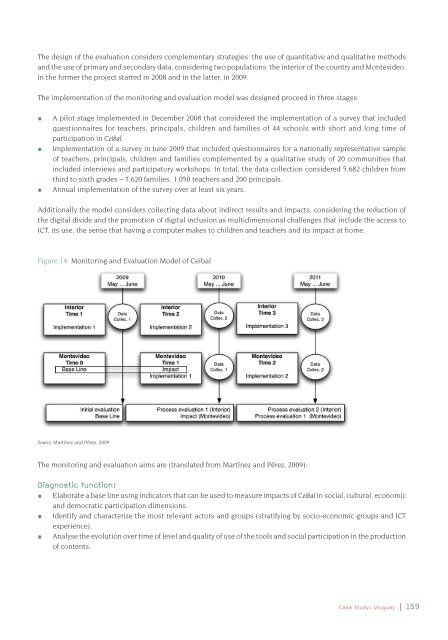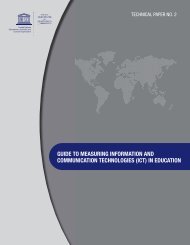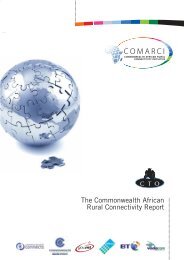Transforming education: the power of ICT policies - Commonwealth ...
Transforming education: the power of ICT policies - Commonwealth ...
Transforming education: the power of ICT policies - Commonwealth ...
You also want an ePaper? Increase the reach of your titles
YUMPU automatically turns print PDFs into web optimized ePapers that Google loves.
The design <strong>of</strong> <strong>the</strong> evaluation considers complementary strategies: <strong>the</strong> use <strong>of</strong> quantitative and qualitative methods<br />
and <strong>the</strong> use <strong>of</strong> primary and secondary data, considering two populations: <strong>the</strong> interior <strong>of</strong> <strong>the</strong> country and Montevideo.<br />
In <strong>the</strong> former <strong>the</strong> project started in 2008 and in <strong>the</strong> latter, in 2009.<br />
The implementation <strong>of</strong> <strong>the</strong> monitoring and evaluation model was designed proceed in three stages:<br />
apple A pilot stage implemented in December 2008 that considered <strong>the</strong> implementation <strong>of</strong> a survey that included<br />
questionnaires for teachers, principals, children and families <strong>of</strong> 44 schools with short and long time <strong>of</strong><br />
participation in Ceibal.<br />
apple Implementation <strong>of</strong> a survey in June 2009 that included questionnaires for a nationally representative sample<br />
<strong>of</strong> teachers, principals, children and families complemented by a qualitative study <strong>of</strong> 20 communities that<br />
included interviews and participatory workshops. In total, <strong>the</strong> data collection considered 5,682 children from<br />
third to sixth grades – 7,620 families, 1,050 teachers and 200 principals.<br />
apple Annual implementation <strong>of</strong> <strong>the</strong> survey over at least six years.<br />
Additionally <strong>the</strong> model considers collecting data about indirect results and impacts, considering <strong>the</strong> reduction <strong>of</strong><br />
<strong>the</strong> digital divide and <strong>the</strong> promotion <strong>of</strong> digital inclusion as multidimensional challenges that include <strong>the</strong> access to<br />
<strong>ICT</strong>, its use, <strong>the</strong> sense that having a computer makes to children and teachers and its impact at home.<br />
Figure 14: Monitoring and Evaluation Model <strong>of</strong> Ceibal<br />
Source: Martínez and Pérez, 2009<br />
The monitoring and evaluation aims are (translated from Martínez and Pérez, 2009):<br />
Diagnostic function:<br />
apple Elaborate a base line using indicators that can be used to measure impacts <strong>of</strong> Ceibal in social, cultural, economic<br />
and democratic participation dimensions.<br />
apple Identify and characterize <strong>the</strong> most relevant actors and groups (stratifying by socio-economic groups and <strong>ICT</strong><br />
experience).<br />
apple Analyse <strong>the</strong> evolution over time <strong>of</strong> level and quality <strong>of</strong> use <strong>of</strong> <strong>the</strong> tools and social participation in <strong>the</strong> production<br />
<strong>of</strong> contents.<br />
Case Study: Uruguay | 159
















